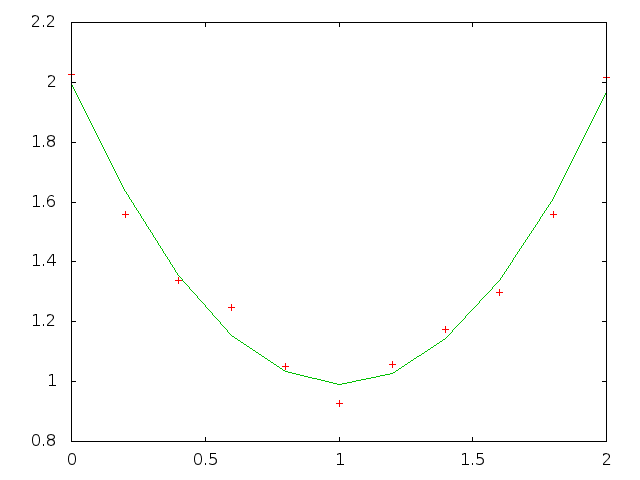19. llsq "poly" Example
% cat poly.ss
// creates noisy polynomial data values,
// then finds LLSQ approximation to the data
srand 23456; // just to make the docs reproducable,
// remove to use default srand(time())
#define M 11 // number of data points
#define N 3 // number of llsq coefficients
#define xCell(c,r) c ## r
#define Cell(c,r) xCell(c,r)
#define Range(c1,r1,c2,r2) xCell(c1,r1):xCell(c2,r2)
#define X Range(a,1,a,M) // X,Y input data points
#define Y Range(b,1,b,M)
#define Z Range(c,1,c,M) // poly approximation Y values
#define Err Range(d,1,d,M) // error
#define Coef Range($e$,1,$e$,N) // poly coefficients
fill X 0, 2/(M-1); a0:e0 = { "X", "Y", "Est", "Err", "Coef" };
Y = { 2+a1*(-2+a1) + (drand()-0.5)/5 }; // y = 2-2*x+x*x + noise
{rank,Coef} = llsq("poly",X,Y); Z = { feval("poly",Coef,a1) };
Err = { R[]C[-2]-R[]C[-1] }; err = sqrt(dot(Err,Err));
eval; plot "poly.out" Range(a,1,c,M);
format "%10.6f"; format A "%5.2f"; print all;
% cat poly.sh
#! /bin/sh
SS -t poly -H poly.ss > poly.html
printf "set term gif\nset output\nplot 'poly.out' using 1:2 with points notitle,\
'poly.out' using 1:3 with lines notitle\n" | gnuplot > poly.gif
rm poly.out
# the points are the original noisy data,
# the line is the polynomial approximation to the data
% ./poly.sh
poly.html

